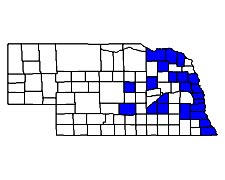
| Cicindela limbalis Klug |
| Adult Length: 12 to 16 mm |
| Appearance: Adults are red dorsally with greenish margins and small markings. The color is somewhat variable and adults may be deep purplish red or even greenish red. The elytral margins are green to blue as well as the margins of the pronotum and the lateral portions of the head. The maculation pattern is somewhat variable and virtually identical to that of C. splendida and C. denverensis. There is a general tendency for individuals at higher elevations to be more heavily marked. |
| Similar Species: This species could potentially be confused with C. scutellaris lecontei or somewhat reddish individuals of C. denverensis. It differs from C. scutellaris in that the luster is comparatively dull. It differs from C. denverensis in the predominance of red, particularly on the head and pronotum. |
| Biology: This species occurs primarily on clay and loess soils. Though it may be found on loamy soils in fairly level areas in the northern parts of the United States and in Canada, it appears to be restricted to fine-particle soils and relatively steep slopes in Nebraska, particularly on steep, eroded clay and loess banks with sparse or no vegetation. It is often found alongside C. splendida, and more rarely with C. denverensis. Adults of this species, C. splendida and C. denverensis are quite skittish and usually land elsewhere back on the steep bank from which they’ve been spooked. |
| Adult Life History: Adults are active mostly in late winter and early spring. Adults emerge from the pupa in August and September. Though some adults may be active into October before overwintering, many remain underground until the following spring. Spring activity begins in March and April, and peak numbers occur in April. Numbers drop rapidly during May, and adults are scarce by the end of the month. It is a spring-fall species. |
| Larval Life History: Eggs are laid mostly in March and April. Most larvae reach the third instar by fall before overwintering. Activity resumes in spring and pupation occurs in July and August. |
| Biogeography: This species has only been collected in the eastern half of Nebraska. The westernmost records in Nebraska are from Buffalo and Valley Counties. It could potentially occur in the westernmost counties as it is not an uncommon species in much of Wyoming. In North America it occurs from central Canada south to New Jersey, Missouri, and Colorado. |


